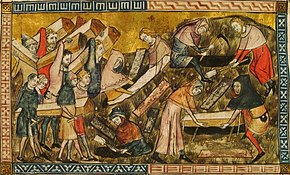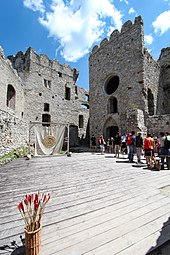
Back أزمة أواخر القرون الوسطى Arabic Krisen i senmiddelalderen Danish Feudalkrise German Krizo de la 14-a jarcento Esperanto Crisis del siglo XIV Spanish Behe Erdi Aroko krisialdia Basque Crise de la fin du Moyen Âge French Kriza 14. stoljeća Croatian Krisis Abad Pertengahan Akhir ID Crisi del XIV secolo Italian


The crisis of the Middle Ages was a series of events in the 14th and 15th centuries that ended centuries of European stability during the late Middle Ages.[1] Three major crises led to radical changes in all areas of society: demographic collapse, political instability, and religious upheavals.[2]
The Great Famine of 1315–1317 and the Black Death of 1347–1351 potentially reduced the European population by half or more as the Medieval Warm Period came to a close and the first century of the Little Ice Age began. It took until 1500 for the European population to regain the levels of 1300.[2] Popular revolts in late medieval Europe and civil wars between nobles such as the English Wars of the Roses were common, with France fighting internally nine times. There were also international conflicts between kingdoms such as France and England in the Hundred Years' War.
The unity of the Catholic Church was shattered by the Western Schism. The Holy Roman Empire was also in decline. In the aftermath of the Great Interregnum (1247–1273), the empire lost cohesion and the separate dynasties of the various German states became more politically important than their union under the emperor.[citation needed]
- ^ James L. Goldsmith (1995), "The Crises of the Late Middle Ages: The Case of France", French History, 9 (4): 417–50, doi:10.1093/fh/9.4.417
- ^ a b Galens, July; Knight, Judson (2001). "The Late Middle Ages". Middle Ages Reference Library. 1. Gale. Retrieved May 15, 2020.
© MMXXIII Rich X Search. We shall prevail. All rights reserved. Rich X Search